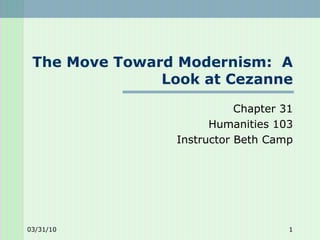Pp Chap31 Cezanne
- 1. The Move Toward Modernism: A Look at Cezanne Chapter 31 Humanities 103 Instructor Beth Camp
- 2. Challenge Questions: Do the paintings by Cezanne reinforce or contradict your understanding of non-representational art? Of abstract painting? As you view these works, select two paintings which you think are “most representative” of Cezanne’s work.
- 3. Cezanne: 1839-1906 Early paintings : Cezanne created fantastic dreamlike scenes and used a heavy palette knife 1872 Cezanne met Monet and began using color to show perspective and light to “recreate nature” Accomplishments: Cezanne developed new type of spatial pattern, showing objects from shifting viewpoints and simple shapes. Strongly influenced CUBISM
- 4. Cezanne Portrait of the Artist's Father c. 1866
- 5. Cezanne: The Abduction, 1867 Does this painting show the influence of the Romantic era? How?
- 6. Cezanne: Bathers at Rest, 1875-1876 Does the use of light here suggest an Impressionist influence?
- 7. Cezanne: Large Bathers, 1899-1906 Can you find triangles in the composition of this painting?
- 8. Cezanne: Still Life with Apples, 1895-1898
- 9. Cezanne (1839-1905) Later years: Major subject was a large mountain near his home, Mont Sainte-Victoire With these paintings, Cezanne “abstracted what he considered nature’s depest truth – its essential tension between stasis and change” (Stokstad 1035)
- 10. Cezanne: Mont Sainte-Victoire, 1885-1895
- 11. Cezanne: Bay from L'Estaquec, 1886
- 12. Cezanne:The Card Players, 1890-1892
- 13. Cezanne Madame Cézanne 1885-1887 Notice how Cezanne creates emotion with color and light
- 14. Cezanne Self-Portrait with Rose Background c. 1875 Did van Gogh influence the background of this painting?
- 15. Cezanne Self-Portrait with Soft Hat c. 1894
- 16. What‚Äôs Next? Challenge Question : In what ways did Cezanne contribute to nonrepresentational art? Can you see how Cezanne influenced Picasso? Sources: ∫›∫›fl£s. Mark Hardin‚Äôs Artchive online. Stokstad, Marilyn. Art History. New York: Harry N. Abrams, 1999.
Editor's Notes
- #4: .
- #5: Image: Mark Hardin Artchive Portrait of the Artist's Father c. 1866 Oil on canvas 198.5 x 119.3 cm (78 1/8 x 47 in.)
- #6: Image: Mark Hardin Artchive The Abduction 1867 Oil on canvas 35 1/4 x 45 1/2" (89.5 x 115.5 cm) Fitzwilliam Museum, Cambridge, UK
- #7: Image: Mark Hardin Artchive Bathers at Rest (Les baigneurs au repos) 1875-1876 Oil on canvas 32 1/4 x 39 7/8 in. (82 x 102.2 cm) The Barnes Foundation, Merion, Pennsylvania
- #8: Image: Mark Hardin Artchive Large Bathers 1899-1906 Oil on canvas 81 7/8 x 98 in (208 x 249 cm) Philadelphia Museum of Art
- #9: Image: Mark Hardin Artchive Still Life with Apples 1895-1898 Oil on canvas 27 x 36 1/2 in (68.8 x 92.7 cm) The Museum of Modern Art, New York Venturi 736
- #10: Source: Marilyn Stokstad, Art History. New York: Harry N. Abrams, 1999.
- #11: Image: Mark Hardin Artchive Mont Sainte-Victoire (La Montagne Sainte-Victoire) 1885-1895 Oil on canvas 28 5/8 x 38 1/8 in. (72.8 x 91.7 cm) The Barnes Foundation, Merion, Pennsylvania
- #12: Image: Mark Hardin Artchive The Bay from L'Estaque c. 1886 Oil on canvas 31 1/2 x 38 1/2 in The Art Institute of Chicago
- #13: Mark Hardin Artchive The Card Players (Les joueurs de cartes) 1890-1892 Oil on canvas 52 3/4 x 71 1/2 in. (134 x 181.5 cm) The Barnes Foundation, Merion, Pennsylvania
- #14: Image: Mark Hardin Artchive Madame Cézanne 1885-1887 Oil on canvas 36 1/2 x 28 3/4 in. (92.6 x 72.9 cm) The Barnes Foundation, Merion, Pennsylvania
- #15: Image: Mark Hardin Artchive Self-Portrait with Rose Background c. 1875 Oil on canvas 26 x 21 5/8" (66 x 55 cm) Private collection Venturi no. 286
- #16: Image: Mark Hardin Artchive Self-Portrait with Soft Hat c. 1894 Oil on canvas 23 5/8 x 19 5/8" (60.2 x 50.1 cm) Bridgestone Museum of Art, Tokyo Venturi no. 579















